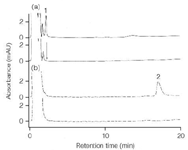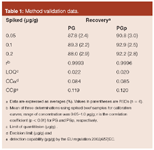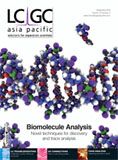A Non-hazardous Technique to Determine Penicillin G and Penicillin G Procaine in Beef
LCGC Asia Pacific
This article describes a simple, rapid and inexpensive method of sample preparation followed by RP-HPLC in beef.
Naoto Furusawa, Graduate School of Human Life Science, Osaka City University, Osaka, Japan.
This article describes a simple, rapid and inexpensive method of sample preparation followed by reversed-phase high performance liquid chromatography (RP HPLC) with diode array (DA) detection to quantify penicillin G (PG) and PG Procaine in beef. The total analytical time was less than 30 min for each sample and no hazardous organic solvents and reagents were used for the analysis.
Penicillin G (PG) is widely used for therapeutic or prophylactic purposes to treat cattle diseases. PG might be applied in the form of procaine salt to achieve longer lasting activity. PG procaine (PGp) is a combination of PG with the local anaesthetic agent, procaine, and is slowly absorbed into the circulation and hydrolysed to PG. It is used where prolonged low concentrations of PG are required. The Codex (Codex Alimentarium Commission) has set a maximum residue limit (MRL) for PG (including PGp) in beef (cattle muscle) at 0.05 µg/g to ensure that beef products for human consumption are virtually residue-free of these substances.1 The acceptable (or ideal) method for the routine monitoring of veterinary drugs in foods of animal origin must be simple, quick, economical in terms of time and cost, and cause negligible harm to the environment and analyst.
Eliminating the use of toxic organic solvents and reagents is an important goal in terms of environmental conservation, human health and the economy. Although high performance liquid chromatography (HPLC) techniques with ultraviolet (UV) detection to simultaneously determine PG and PGp in plasma2 or serum3 have been reported, there is no method that does not use toxic solvents/reagents. This article describes a rapid and inexpensive technique that does not use hazardous chemicals to monitor PG and PGp residues in beef.
Experimental
Reagents and apparatus: Penicillin G potassium (PG) and penicillin G procaine (PGp) standards were purchased from Wako Pure Chem. (Osaka, Japan) and Nippon Zenyaku Kyogyo (Koriyama, Japan), respectively. Ethanol (purity 99.5%) and distilled water were of HPLC grade (Wako). Stock standard solutions of PG and PGp were prepared by dissolving each of the compounds in water to a concentration of 100 µg/mL. Working mixed standard solutions of these compounds were prepared by diluting the stock solutions with water. A handheld ultrasonic-homogenizer (model HOM-100, 2 mm i.d. probe, Iwaki Glass, Funabashi, Japan), a micro-centrifuge (Biofuge fresco, Kendo Lab. Products, Hanau, Germany), and an Ultrafree-MC/PL (Millipore, Bedford, Massachusetts, USA) as a centrifugal ultra-filtration unit were used in the sample preparation.
HPLC: The HPLC system included a model PU-980 pump and DG-980-50 degasser (both from Jasco Corp., Tokyo, Japan), as well as a model SPD-M10A VP photo-diode array (PDA) detector (Shimadzu Scientific Instruments, Kyoto, Japan). The analytical column was an Inertsil WC300C4 (100 × 4.6 mm, 5 µm) column (GL Science, Tokyo, Japan). The isocratic mobile phase was 0.04 mol/L phosphoric acid (pH 7.0)–ethanol (8:2, v/v) and the flow-rate was 1.0 mL/min. PDA detector was scanned from 190–350 nm: detecting at 205 nm for PG and 290 nm for PGp, respectively (a maximum UV absorption for each compound). The column temperature was operated at 40 °C The injection volume was 20 µL.
Sample preparation: An accurately weighed 0.1 g homogenized beef sample was placed in a micro-centrifuge tube and homogenized with the ultrasonic homogenizer for 30 s with 0.6 mL of ethanol. After being homogenized, the capped tube was centrifuged at 12000 g for 5 min. A 50 µL portion of supernatant liquid was placed into an Ultrafree-MC/PL and centrifuged at 5000 g for 5 min. The ultra-filtrate was injected into an HPLC system.
Recovery test: The recoveries of PG and PGp from blank beef samples spiked at 0.05, 0.1 and 0.2 µg/g, respectively, were determined. These fortification levels were prepared by adding 10 µL of three working mixed standard solutions, 10, 20 and 40 µg/mL, respectively, to separate 2 g portions of the samples. Fortified samples were allowed to stand at 4 °C for 24 h after the mixed standard addition and then mixed prior to the test.

Figure 1: Chromatograms obtained from the HPLC system. PDA detector set at (a) 205 nm or (b) 290 nm. Upper profile: a beef (cattle muscle) sample spiked with the target compounds (0.2 µg/g). Lower profile: (a) a blank beef sample. Peaks: PG (Retention time) = 2.4 min; 2 = PGp (17.3 min).An arrow in (a) lower profile indicates the peak of PG.
Results and Discussion
Figure 1 displays typical chromatograms for beef samples obtained under the procedure developed here. This figure demonstrates that the present method can provide quantifications and identifications of PG and PGp.

Table 1: Method validation data.
Table 1 summarizes the main 'Method Validation' parameters. The author generated the spiked recovery graph as a practical calibration curve plotting peak areas of fortified sample extracts ranging from 0.05–1.0 µg/g versus their concentration. The decision limit (CCα, µg/g) and detection capability (CCβ, µg/g) values calculated according to the EU regulation4 are also described in this table. Additionally, the selectivity and cost/time performances are as follows: the target spectra obtained from the beef sample were practically identical to those of the standards. Because of the high absorbance of PG and PGp and the satisfactorily purification, UV detection is possible at trace levels using PDA.
It is, therefore, instructive to demonstrate the purification effectiveness of the sample preparation. The present HPLC system made it unnecessary to use MS, which is very expensive and is not available in a lot of labs for routine analysis, particularly in developing countries, to analyse the target compounds. The time and budget required for the analysis of one sample were less than 30 min and roughly €3.9 (¥500 in 16 March 2009), respectively. For the sequential sample preparations, a batch of 12 samples can be analysed in less than 4.5 h.
Residue monitoring in commercial beef: Using the complete method, the author analysed the different samples of marketed beef in Osaka, Japan. No beef samples contained detectable concentrations of PG (< 0.022 µg/g) and PGp (< 0.020 µg/g), respectively. The chromatograms were free from interference.
Conclusions
The proposed method is a useful tool for routine residue monitoring of PG and PGp in beef which is inexpensive, harmless to the environment, quick and delivers reproducible recoveries.
Naoto Furusawa is an associate professor with the Graduate School of Human Life Science, Osaka City University, Osaka 558-8585, Japan.
References
1. Codex Alimentarius Commission (http://www.codexalimentarius.net/mrls/vetdrugs/jsp/vetd_q-e.jsp)
2. Y. Luo et al., Journal of Chromatography B, 714, 269 (1998).
3. A. Ghassempour et al., Talanta, 65, 1038 (2005).
4. EU Decision 2002/657, 2002 Official Journal of European Communication L221/8.

Analytical Challenges in Measuring Migration from Food Contact Materials
November 2nd 2015Food contact materials contain low molecular weight additives and processing aids which can migrate into foods leading to trace levels of contamination. Food safety is ensured through regulations, comprising compositional controls and migration limits, which present a significant analytical challenge to the food industry to ensure compliance and demonstrate due diligence. Of the various analytical approaches, LC-MS/MS has proved to be an essential tool in monitoring migration of target compounds into foods, and more sophisticated approaches such as LC-high resolution MS (Orbitrap) are being increasingly used for untargeted analysis to monitor non-intentionally added substances. This podcast will provide an overview to this area, illustrated with various applications showing current approaches being employed.











